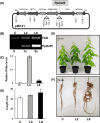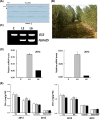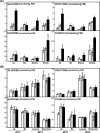Overexpression of a pine Dof transcription factor in hybrid poplars: A comparative study in trees growing under controlled and natural conditions
- PMID: 28376100
- PMCID: PMC5380328
- DOI: 10.1371/journal.pone.0174748
Overexpression of a pine Dof transcription factor in hybrid poplars: A comparative study in trees growing under controlled and natural conditions
Abstract
In this work, the role of the pine transcriptional regulator Dof 5 in carbon and nitrogen metabolism has been examined in poplar trees. The overexpression of the gene and potential effects on growth and biomass production were compared between trees growing in a growth chamber under controlled conditions and trees growing in a field trial during two growth seasons. Ten-week-old transgenic poplars exhibited higher growth than untransformed controls and exhibited enhanced capacity for inorganic nitrogen uptake in the form of nitrate. Furthermore, the transgenic trees accumulated significantly more carbohydrates such as glucose, fructose, sucrose and starch. Lignin content increased in the basal part of the stem likely due to the thicker stem of the transformed plants. The enhanced levels of lignin were correlated with higher expression of the PAL1 and GS1.3 genes, which encode key enzymes involved in the phenylalanine deamination required for lignin biosynthesis. However, the results in the field trial experiment diverged from those observed in the chamber system. The lines overexpressing PpDof5 showed attenuated growth during the two growing seasons and no modification of carbon or nitrogen metabolism. These results were not associated with a decrease in the expression of the transgene, but they can be ascribed to the nitrogen available in the field soil compared to that available for growth under controlled conditions. This work highlights the paramount importance of testing transgenic lines in field trials.
Conflict of interest statement
Figures






Similar articles
-
Poplar trees for phytoremediation of high levels of nitrate and applications in bioenergy.Plant Biotechnol J. 2016 Jan;14(1):299-312. doi: 10.1111/pbi.12384. Epub 2015 Apr 28. Plant Biotechnol J. 2016. PMID: 25923308 Free PMC article.
-
The overexpression of the pine transcription factor PpDof5 in Arabidopsis leads to increased lignin content and affects carbon and nitrogen metabolism.Physiol Plant. 2015 Dec;155(4):369-83. doi: 10.1111/ppl.12381. Epub 2015 Oct 7. Physiol Plant. 2015. PMID: 26333592
-
Overexpressing GLUTAMINE SYNTHETASE 1;2 maintains carbon and nitrogen balance under high-ammonium conditions and results in increased tolerance to ammonium toxicity in hybrid poplar.J Exp Bot. 2024 Jul 10;75(13):4052-4073. doi: 10.1093/jxb/erae124. J Exp Bot. 2024. PMID: 38497908
-
Adventitious root formation in tree species: involvement of transcription factors.Physiol Plant. 2014 Jun;151(2):192-8. doi: 10.1111/ppl.12197. Physiol Plant. 2014. PMID: 24666319 Review.
-
Overexpression of PsnSuSy1, 2 genes enhances secondary cell wall thickening, vegetative growth, and mechanical strength in transgenic tobacco.Plant Mol Biol. 2019 Jun;100(3):215-230. doi: 10.1007/s11103-019-00850-w. Epub 2019 May 4. Plant Mol Biol. 2019. Retraction in: Plant Mol Biol. 2023 May;112(1-2):105. doi: 10.1007/s11103-023-01353-5. PMID: 31053988 Retracted. Review.
Cited by
-
Characterization of a High Hierarchical Regulator, PtrGATA12, Functioning in Differentially Regulating Secondary Wall Component Biosynthesis in Populus trichocarpa.Front Plant Sci. 2021 Apr 21;12:657787. doi: 10.3389/fpls.2021.657787. eCollection 2021. Front Plant Sci. 2021. PMID: 33968111 Free PMC article.
-
DOF transcription factors: Specific regulators of plant biological processes.Front Plant Sci. 2023 Jan 20;14:1044918. doi: 10.3389/fpls.2023.1044918. eCollection 2023. Front Plant Sci. 2023. PMID: 36743498 Free PMC article. Review.
-
Ectopic expression of the AtCDF1 transcription factor in potato enhances tuber starch and amino acid contents and yield under open field conditions.Front Plant Sci. 2023 Mar 1;14:1010669. doi: 10.3389/fpls.2023.1010669. eCollection 2023. Front Plant Sci. 2023. PMID: 36937996 Free PMC article.
-
Genetic Engineering and Genome Editing for Improving Nitrogen Use Efficiency in Plants.Cells. 2021 Nov 25;10(12):3303. doi: 10.3390/cells10123303. Cells. 2021. PMID: 34943810 Free PMC article. Review.
-
SNPeffect: identifying functional roles of SNPs using metabolic networks.Plant J. 2020 Jul;103(2):512-531. doi: 10.1111/tpj.14746. Epub 2020 Apr 18. Plant J. 2020. PMID: 32167625 Free PMC article.
References
-
- Fedenko J, Erickson J, Woodard K, Sollenberger L, Vendramini JMB, Gilbert RA, et al. Biomass production and composition of perennial grasses grown for bioenergy in a subtropical climate across Florida, USA. Bioenergy Res. 2013; 6: 1082–193.
-
- Sannigrahi P, Ragauskas AJ, Tuskan GA. Poplar as a feedstock for biofuels: A review of compositional characteristics. Biofuels Bioprod Bior. 2010; 4: 209–226.
-
- Fuentes SI, Allen DJ, Ortiz-Lopez A, Hernández G, Over-expression of cytosolic glutamine synthetase increses photosynthesis and growth at low nitrogen concentrations. J. Exp. Bot. 2001; 52:1071–1081. - PubMed
Publication types
MeSH terms
Substances
LinkOut - more resources
Full Text Sources
Other Literature Sources

